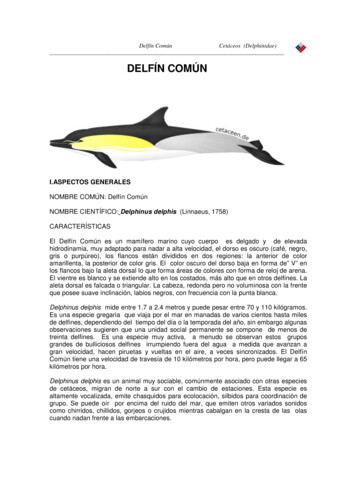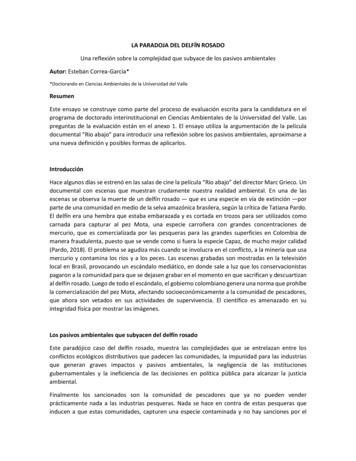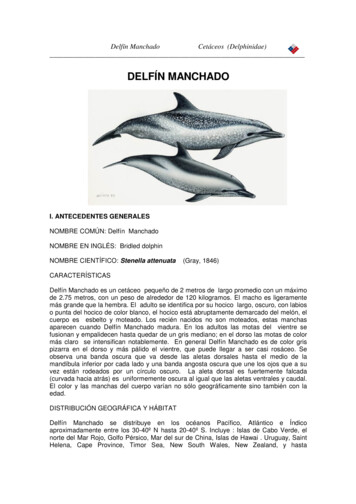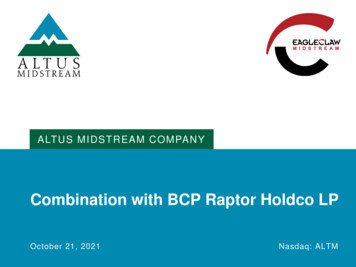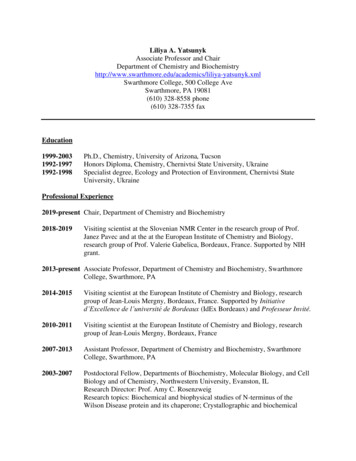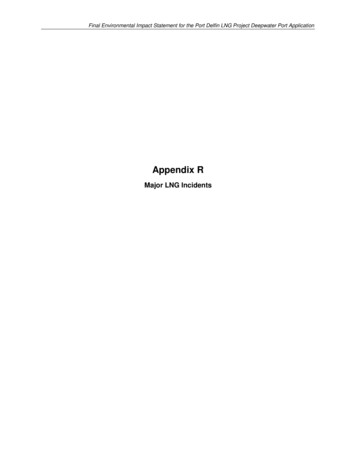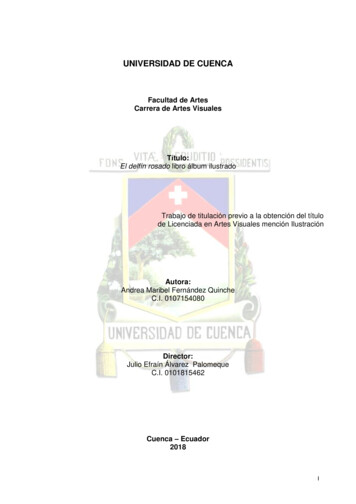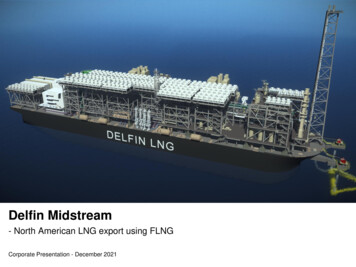
Transcription
Delfin Midstream- North American LNG export using FLNGCorporate Presentation - December 2021
Table of contents1Introduction to Delfin Midstream2Business Model & Expansionopportunities3Delfin LNG Project4FLNG Technology & Operations5Outlook2
Introduction to Delfin MidstreamLeading developer of LNG export projects in North America using FLNGDelfin Midstream in briefDelfin Midstream - US Gulf LNG export projects Leading developer of North America LNG export projects using FLNG technology Station 44GrandChenierPipeline(42”, 26nm)Owner of the 42” UTOS offshore pipeline and access agreement for 42” HIOS pipelineLarge number of existing underutilized pipeline connections to liquid gas pools in the areaNon-FTA export licensed from DOE for 13 MTPACompleted all permitting work with MARAD & USCGNewbuild FLNG – FEED completed with Samsung & Black & Veatch(30”, 37nm)WC 171WC 167HIOSPipeline Low cost, flexible asset allows significantly more commercial flexibility GrandChenierStationUTOSPipeline Fully permitted and required pipelines and infrastructure in place Avocet LNGDelfin LNGLower costs & FID thresholds than other US LNG export opportunitiesExperienced management with proven FLNG, FSRU and LNGC track recordSignificantly more commercial and operational flexibility vs land-based projectsCompleted low carbon e-FLNG preFEED and developing other ESG solutionsEach FLNG vessel can be executed as an independent projectStandard SPA offer of 115% of HH plus 2.00 for 20 years. Shorter term also availableHH indexed FOB SPAs, tolling, integrated upstream structures (indexed to LNG prices with a capand floor) and other bankable structures are possibleFLNGV5(42”, 18nm)FLNGV6FLNGV1FLNGV3 Offshore floating project at a dedicated port 2-3 times more berth space per unit of production compared to land-based projectsAllows wider loading windows, Small scale and LNG bunkering, easy port accessFully permitted deepwater port withCompetitive FID threshold ofFLNGV2FLNGV4Low cost US LNG ofCompetitive, all-in capex of13 MTPA2.0 – 2.5 MTPA 550 /tpa 2bn per FLNGVNon-FTA export license capacity(4 FLNG Vessels)per FLNG Vessel with fullcommercial flexibilityreflecting attractive cost advantagecompared to most US projectsvs 8-12bn forland-based terminals3
Highly experienced team with unique track recordBringing the most experienced FLNG players together for a low-cost FLNGOscar Spieler – Executive ChairmanExtensive experience in commercial and technicaldevelopment of floating assets: Previous CEO of Golar LNG, Frontline and Sea Production, currently boardmember ofQuantafuel Board experience from multiple companies within the shipping, drilling and finance sectors, incl.OMP, Energy Drilling, Jasper Investments, Archer, Avenir LNG, North Atlantic Drilling and Sealift M.Sc. in Naval Architecture and Engineering from the Norwegian University of Science andTechnology 150 years combined LNG industry experience at senior mgmt Executed commercial agreements and project management formultiple FSRUs Executed commercial agreements and EPC for Golar Hilli FLNGV Negotiated first FLNG LSTK EPCIC with SamsungDudley Poston, CEO EVP at Golar LNG from 2010-2018, focusing on the commercial development of FloatingStorage and Regasification Units, Floating Liquefaction, and small-scale LNG Prior to joining Golar, 16 years of experience in the U.S. natural gas industry as a financial andphysical trader for Koch Industries, The Williams Companies, and Citigroup B.A. in Government from the University of Texas, M.A. in Economics from The State Universityof New York, and M.S. in Finance from Texas A&M UniversitySuccessful execution of FLNG Hilli Episeyo on budgetand on time (From FID to COD in less than 4 years): EPC schedule 41 months Total costs (into service) 500/t (nameplate basis) 100% commercial availability since COD in May 2018Wouter Pastoor, COO Head of Commercial and Director of FLNG Development at Golar from 2014 to 2018, focusingon the Hilli, Fortuna and Tortue projects and leading new FLNG design & businessdevelopments Prior to joining Golar, 13 years of experience in the LNG industry, primarily focused on technicaland commercial development of Floating LNG projects at FLEX LNG, Höegh LNG and BWO Ph.D. and M.Sc. in Naval Architecture and Ship Hydromechanics from the Delft University ofTechnology in the Netherlands World’s first Lump Sum Turn-Key EPCIC for FLNG developed by FLEX LNG withSamsung Heavy Industries in 2008 Successful construction of newbuild FLNGs (Prelude, PFLNG-2, Coral FLNG) World’s first conversion FLNG executed and successful in operation (Golar’s Hilli)with Black&Veatch topside design and PRICO liquefaction technology Process and topside contractor for Exmar FLNG and FLNG GimiFloating LNG competence enabling Delfin to expandinto new FLNG projects and integrate shipping andfloating regasification into a value chain JVSuccessful FLNG projectsGolor Hilli FLNGGolar GimiExmar FLNG bargePetronas FLNG 2CameroonSenegalArgentinaMalaysia4
Capitalizing on two major industry revolutionsDelfin is in the front seat of the floating LNG revolutionFloating LNG revolutionShale revolutionThe combination: 45 FSRUs have opened upnew markets and many newimport countries, importing 1015% of global LNG supply7 FLNGs in operation or underconstruction (supplying 5%of global LNG)The LNG market is stuck with traditional models that do not address the world’s demand forlow cost, flexible LNG to become a preferred fuel-of-choice over coal and liquids The traditional model is pursuing “economies-of-scale” with major projects of 10 MTPA requiring many long-term offtakecontracts to underpin the financing The world markets need low-cost, flexible LNG supply and has limited capacity to underpin major conventional projects The solution: Standardized floating LNG allows the costs to be 20-40% cheaper with FID thresholds of just 2.0 - 2.5 MTPA5
Delfin in the LNG value chainHighly attractive project portfolio and expansion opportunities in the value chainEnd users(power, industry,heating, domesticuse, etc.)REGASFLNGUpstream supply &transportationPipeline Owns the 42” UTOS pipeline Access agreement for 42”HIOS pipeline Liquefaction Avocet LNG Other easy-accessible gassourcesNewbuild FLNG FEEDOfftake completed100% owner of 30” GrandChenier pipeline throughFSRULNGC Regasification/ end usersAll permitting workcompletedOwner and operator of the 13 MTPA export licenseDelfin Deepwater Port Advanced discussions on4 FLNG projects with a totalofftake with multipleof 13 MTPA export capacitypotential partnersSuccessful development ofexpansion projectsOpportunistic approach to strategic partnerships in the value chain new commercial models6
Table of contents1Introduction to Delfin Midstream2Business Model & Expansionopportunities3Delfin LNG Project4FLNG Technology & Operations5Outlook7
The most competitive North American LNGLower costs & project viability thresholds than competitors Faster time to FID20-40% lower Capex compared to land-based ProjectsLower unit costs and lower FID threshold enable: Discounted pricing (Tolling fee / LNG price)Standard offer of 115%HH 2.00 for 20 year term or 115%HH 2.40 for a 10 year term Shorter terms of LNG15, 12 or even 10 years Flexible pricingFlexible tolling fee fluctuating between a floor and a ceiling basedon an agreed index (HH, JKM, TTF, Brent, blend, etc.) Higher FID likelihoodWith just 2.5 MTPA sold, Delfin can take FID on a FLNG VesselMaterial cost savings achieved through: Utilizing existing pipelines No need for new onshore pipelines Low-cost Asian labor Standardization of generic liquefier FLNGtechnology Manufacturing-like construction processin shipyard Construction at existing yard whicheliminates investments on sites andutilities to enable plant fabrication LNG offloading is done in a side-by-sideconfiguration, which eliminates the needfor long cryogenic pipelines and marineinfrastructure (the LNGC berth is anintegral part of the FLNG) Enhanced commercial flexibilityEach FLNG Vessel will have its own commercial/financialstructure and its own FID. Each FLNGV can therefore have itsown model tailored to its Clients, e.g. Upstream producers candevelop a 50% FLNG export position with just 250 mmscfd of theirgas production portfolio Offtaker equity participationWith each FLNG Vessel having its own FID, commercial structureand ownership it allows equity participation to Clients Slot flexibilityDelfin can offer slot flexibility to Clients that wish to maintainoptionality on their FID timing Reduced environmental footprintEnhanced environmental performance to reduce overall footprint8
Commercial Structuring – Maximum FlexibilityFinancing of US Export Projects Financing is a key commercial constraint for each project US projects have been financed on the back of HH offtakecommitments with credit worthy offtakers or long-term tollingagreementsDelfin is Uniquely Different FID in smaller increments at lower unit costs Built in an Asian shipyard supporting vendor and Export Credit Agencyfinancing Each FLNG Vessel can make FID independently, with it’s ownfinancing and commercial model Flexible asset, which can be re-deployed (facilitate shorter contracts,asset intrinsic value)A) Traditional Toll or HH Indexed FOB (10-20 years)Toll can be flexible and be partially indexed to LNG prices, Brent, orother indices or a mix in cooperation with Buyer or ProducerIllustration of Delfin’s commercial optionalityUpstream hydrocarbonreservesUpstream Integration /Upstream led marketingUTOSJV of upstream reserves witha dedicated FLNGV slotselling LNG on SPA basis or aProducer led LNG FOB saleAvocetToll / LNG SPA FOB(e.g. fixed, flexible, HH, Brent,TTF, JKM, mixed, . . .)HIOSB) Integrated Upstream-Liquefaction Joint VentureReserves FLNG vessel are in a JV that produces gas, transports gasto the FLNG vessel and sells FOB LNG (on an index basis)FLNGV-3LNG bunkering FOBFLNGV-2FLNGV-1LNGC BunkerFLNGV-4C) Strategic Partnerships (e.g. Traders/Producers)Delfin and Partner Joint Venture with (certain) balance sheet supportfrom Partner(s) supporting debt financingLNGCD) Integrated LNG-to-Power projectDelfin contributes a dedicated FLNG slot to an integrated value chaindevelopment, creating full value chain alignmentE)LNG FOB to bunker / small-scale buyersBunkering and small-scale volumes sold on small parcel basisLNGCLNG DES SPA(e.g. fixed, flexible,HH, Brent, TTF, JKM,mixed, . . .)Downstream IntegrationJV of liquefaction anddownstream marketFSRUGas-to-PowerGas distributionLNG break-bulk9
A Differentiated Business ModelOpportunity for co-ownership, participation and local contentsREGASFSRU Refurbishment and conversion ofLNGC into FSRUFabrication of mooring componentsCo-ownership and operationsFLNG Ownershipand O&MLNG Offtake, Shipping &ArbitrageFloating LNG Import F L N GLNGC LNG Offtake (DES / FOB /Tolling)ShippingCommercial /logisticsoptimisation Co-ownership inFLNG VesselO&M developmentand participationFLNGConstruction Local fabrication andconstruction of partsof the FLNG scope assubcontractor to mainEPC contractorUpstream supply &Transportation Option to produce/procureNorth American shale gas asfeed gas supply forliquefaction onboard theFLNGV ( integrated project)Participation options throughout the value chain for LNG Buyers, Strategic Investors orother Key Stakeholders (yards, financiers) in an LNG value chain development10
Leveraging Technology Value from Delfin LNGThe Delfin FLNG Technology is a generic Liquefier for use across North AmericaDelfin Liquefier FLNGReceives pipeline quality feedgas“Variations-on-a-theme”Canada FLNGAvocet FLNGMexico FLNGSouthTexas FLNGGeneric Liquefiers with minor adjustments to suit location specific requirements11
Attractive expansion opportunitiesMultiple options for liquefaction expansion beyond the first 4 FLNG vesselsEastern Canada – 4-8 MTPA Cedar LNGExisting Offshore Oil ProductionStranded Gas can be piped to shoreCost Competitive with USGC Into NW EuropeRequires Gas Pipeline Successful completion of preFEED Divested shareholding, but maintainingan economic interest in the project Continuing supporting the Cedar projectAvocet LNG – 14 MTPA Avocet 100% owned by DMI Permitting scoping work ongoing Opportunity to acquire adjacentpipeline (additional 6 MTPA) Evaluation for expansion / integrationwith Delfin LNG project ongoingMexico LNG Opportunities for several FLNGVessels utilizing existing pipelinecapacities sourcing back to the US Opportunity to leverage existingfacilities and licences to enable a shortdevelopment timeline with limitedregulatory risksDelfin LNG – 13 MTPASouth Texas – 7 MTPA Pipeline screening ongoingEvaluation of gas supply optionsPricing and commercial evaluationsPreparing scoping work for permittingwork(Anchor Project) Fully permitted as Deepwater Port withMARAD/USCG and 13 MTPA DoEExport Licence Completed conversion and NewbuildFLNG FEEDs Financial structuring and full LSTKEPCIC contractingDelfin Midstream has identified over 40 MTPA of liquefaction opportunities that have access tooperating or post-FID pipelines. All locations can use Delfin’s FLNG technology12
Dual Expansion – Capacity and Value ChainUpstreamGasAggregation& TransportLiquefactionShippingRegas &TerminalPipeline &Power PlantDistributionIntegrated Project: LNG-to-PowerIntegrated ProjectsUpstream & FLNGIntegrated Project: Small-scale distributionAnchor Project(13 MTPA)Integrated Project: LNG BunkeringCedar LNG(1)(3 MTPA)Avocet LNG (14 MTPA)Mexico LNG(3.5 MTPA)South Texas LNG(7 MTPA) Capacity expansion opportunity of 30 MTPA by leveraging its 13 MTPA anchor project FLNG Vessel slots allow integration into the value chain Upstream and DownstreamNotes: (1) Delfin divested its shareholding but maintains an interest and continues supporting the project13
Table of contents1Introduction to Delfin Midstream2Business Model & Expansionopportunities3Delfin LNG Project4FLNG Technology & Operations5Outlook14
Delfin LNG projectIndicative Project & Contracting StructureProject InfrastructureDelfin LNGStation 44Delfin LNG CompressorStationAvocetExpansionproject 3Etc. . .UTOSPipeline(42”, 26nm)O&M ServicesFLNG #2WC 167FLNG #3FLNG #4HIOSPipelineEtc. . .Lenders(42”, 18nm)Project debtTolling /LNG SPAFLNG #1 Project Co.InfrastructureFunds“Client”(Toller, FOB Buyer, Producer,.)GSA(in case of LNG SPA)Project equityFLNGV1FLNGV3LSTK EPCICEPCIGas Co./ Pipeline CoFLNGV2Mooring &InstallationFLNGV415
Permitting SuccessSuccessfully Permitted the First FLNG Project in North AmericaMajor Milestones Accomplished DOE approval to export gas to Free Trade Agreement (“FTA”) countries Pre-filing work for Maritime Administration (“MARAD”) and Federal Energy Regulatory Commission(“FERC”) permits Formal submission of MARAD and FERC permits Receipt of MARAD determination that application was “complete” Successful modification of application for change in technical design Receipt of Draft Environmental Impact Statement (“DEIS”) Receipt of Final Environmental Impact Statement (“FEIS”) Receipt of Record of Decision (“ROD”) DOE approval to export gas to Non-Free Trade Agreement (“FTA”) countries FERC Order Received for Land-based infrastructureNotable Reports / Ancillary Permits Application to Louisiana Department of Natural Resources Application to US Army Corps of Engineers Coastal Zone Management Consistency Certification for Louisiana Coastal Zone Management Consistency Certification for Texas US Environmental Protection Agency (“EPA”) Region 6 Permit Louisiana Department of Environmental Air Permit for onshore facilities Port Operations Manual Various modeling reports – air, noise, dispersion, spill consequence 12 resource reports for FERC Certificate of Public Convenience and NecessityPermitting of Avocet and expansion projects in Gulf of Mexico willleverage from the Delfin development and permitting work16
No need to build new onshore pipelinesDetailed discussions on pipeline capacity to serve the first FLNG Vessels Multiple options have been identified allowing Delfinto secure pipeline capacity for the first 2 or 4FLNGVs Pipeline capacities can be increased by addingcompression and/or reversals. No new pipe required Detailed discussions with several pipeline companiesto access volumes from multiple basins –Haynesville, Marcellus, Barnett and Permian Given the smaller capacity needed per FLNG VesselFID there is ample opportunity to utilize existingunderutilized pipelines Lake CharlesPort ArthurUTOSAvocetAdditional expansions can be created by loopingadditional pipeHIOS Off-takers may prefer accessing their own gas or gascan be provided by Delfin or a 3rd party traderDelfinDeepwater PortSource: Company information, EIA17
Delfin FLNG VesselLowest cost LNG - Smallest FID threshold - Maximum commercial flexibilityAccommodation &Electrical roomsAir coolers for liquefactionand process utility systemsHelideck (PS)Train 2 (PS)Air cooling utility systemsTrain 1 (PS)Inlet & pre-treatmentAft machinery spaceSelf-propelled vesselwith 3 azimuthingthrusters4x2 reinforced membranetype LNG tanksMarine Loading ArmsForward machinery &Electrical roomsFeedgas riser& umbilicalDisconnectablemooring18
Delfin LNG – Unique Environmental CharacteristicsPartly BrownfieldLeverage ExistingInfrastructureMinimalEnvironmental ImpactOffshoreCompact DesignDelfin FLNG - GHG EfficiencyDelfinLNG Efficient, optimized PRICO liquefaction Direct Air Cooling Inlet Air Chilling (IAC) for maximum productionand efficiency Waste-heat recovery for process heating andmain power generation Supplemental power by efficient DF generators No venting and flaring in normal operationSource: Oxford Energy Studies (“Delfin LNG” added by Company, including an assumptionof 1.2% CO2 in feedgas being removed and included in the GHG calculation)Being offshore Delfin is uniquely positioned to develop carbon-neutral production solutionsE-driveliquefactionA. Electric-drive FLNGFeedgasRenewable PowerE- F L N GCO2 captureB. Carbon-capture & OffshoresequestrationF L N GCO2FeedgasOffshore sequestrationCO2 captureC. Carbon-capture & short-seaCO2 shippingCO2LiquidCO2F L N GFeedgasCO2 shipping for distributionto consumers19
Future Potential: e-FLNGCompleted pre-FEED for electric driven FLNG - Delfin e-FLNGe-FLNG Pre-FEED conducted by leveraging theDelfin FLNG FEED design The Delfin e-FLNG is a 2-train liquefierFLNG using PRICO liquefactiontechnology Developed to receive renewable powersupply from shore Specific design solutions developed toaddress the e-drive particulars:opower supply & management,oelectric drive technologiesoprocess heat,oHHC removal & disposal,onitrogen rejection Delfin developed e-FLNG for the CedarLNG projectThe application of an e-FLNG can reduce GHG emissions by 75%20
Table of contents1Introduction to Delfin Midstream2Business Model & Expansionopportunities3Delfin LNG Project4FLNG Technology & Operations5Outlook21
FLNG History & OutlookFLNG GrowthIn operation /constructionFirst FIDsPioneering workKey Factors:Tango Technical concepts Business Models Contract &Gimi(1)Execution ModelsHilli EpiseyoA Clients / partners /PFLNG-1BVarious proposal and studiesbut with limited dePFLNG-2Coral FLNG(1)20072016Original business model15 years later: 2 types of FLNG“Monetization of stranded reserves”(see next slide for details)ALiquefier FLNGBLNG FPSOThe technology:LNG FPSO(1) Under construction22
“Liquefier” vs “Wellstream Producer”ADelfin Liquefier FLNGBWellstream Producer LNG FPSOReceives pipeline quality feedgasProduces a raw wellstream from a reservoir(s)Lower CAPEX & OPEX – Standardization – Highavailability - RedeployableProject/Field specific – additional complex process systems reservoir/well operations – higher CAPEX & OPEXTypical additional features Reservoir, well and subsea controls Multiple risers and umbilical system Flow assurance systems Inlet separation and treatment (water,sand, impurities, liquids, etc.) Condensate / LPG separation, handling,storage and offloading Additional utility and support systems23
Liquefier FLNG North America “Win-Win”Liquefier FLNG vessels 500 /tonWellstream producing FLNG 1000 /ton- Standardized solution for pipeline quality gas -- Bespoke solution for a dedicated reservoir -Exmar FLNG bargepast YPF ArgentinaGolar Hilli Episeyo,CameroonBPK / Golar GimiMauritania/SenegalPetronas FLNG-1MalaysiaSuccessful execution and production performanceFrom FID to COD in less than 4 years EPC schedule 41 months Total costs (into service) 500/tpa (on nameplate basis) 100% commercial availability since COD in May 2018 XLower CAPEX & OPEX – standard process systems –high availability - redeployableStep 1: Standardized generic ‘liquefier FLNG design’Step 2: Manufacturing style of construction under LSTK EPCICStep 3: Apply to the North American marketStep 4: Build multiple unitsPetronas FLNG-2MalaysiaENI Coral FLNGMozambiqueHigher costs and higher risks Higher execution and performance risk Higher CAPEX and OPEX Bespoke and complex process and support systems Oil Co. / Major Utility execution/cooperation modelsSuccessful delivery and operational performanceDelfin’s Strategy:Leveraging the success of liquefier FLNG solutionsShell Prelude FLNGAustraliaSignificant execution and performance riskHigh CAPEX & OPEX – bespoke, complex process systems –reservoir/well operations – upstream riskThe BenefitsA.B.C.D.E.F.Low cost & low complex FLNG designMinimal execution riskNo upstream risksNo country / political risksAbundant, low-cost gas with standardized pipeline quality specsLower financing costs (infrastructure not upstream/country risk)Source: Golar, Company Information24
FLNG Vessel Designs3 FLNGV designs provide commercial & geographic flexibilityLSTK EPCICCommon particulars for all three FLNG Vessel designs 2-train PRICO liquefaction technology with parallel drives per train Single train pre-treatment design (AGRU, Dehydration, Hg removal)FLNG NewbuildingConsortium Modularized topsides with air cooling for hull and topside systems Side-by-side offloading Offshore Classed and Flag with minimum 25 years design lifeA. Newbuild FLNG Vessel (Delfin LNG) Completed FEED LSTK EPCIC Term Sheet negotiated Consortium of Samsung and Black & Veatch responsible under a single contract for ”EPC wrap”, withcompletion, schedule and performance guarantees satisfying project financeB. Conversion FLNG Vessel (Delfin LNG)Offshore Installation, Ship-Shaped LNGProduction and Storage Unit, POSMOOR,1A, R, BIS, HELIDK (optional) Conversion of a modern Moss LNG carrier Lengthening of vessel with insertion of new midship section FEED completed and EPC bids received Cooperation with Chinese (or Singaporean) shipyards and Black & VeatchC. Electric-driven Newbuild FLNG Barge (developed for Cedar LNG) Newbuild barge Electric driven (Hydro-power supply from shore) Pre-FEED completed Cooperation with Consortium of Samsung and Black & Veatch25
FEED Completed1. Robust, safe and efficient2. Accurate and detailed cost build-up3. LSTK EPCIC Term Sheet enabling project finance4. Leverage and enhance offshore proven PRICO design5. Minimize environmental impact and maximize fuel efficiency6. Robust design and procedures to avoid severe hurricanes7. Include LNG bunkering and small-scale offloading facilities8. Leverage most experienced FLNG players using standardizedsolutions and shipbuilding practices in a collaboration ofpartnership and trustKey ContractorsBased on the generic 2-train FLNG design Delfin isdeveloping location-specific applications for additionalNorth American projects, e.g. hydropower electric-drivenFLNG concept producing “low carbon” LNG for the CedarLNG project26
PRICO SMR – Proven FLNG TechnologyWhy PRICO SMR?Proven for Offshore FLNG applications Well proven on onshore and floating applications Simple in operation (starting, stopping, re-starting, turn-down) Well managed technical risks Proven offshore with low costs Applied over a broad range of capacities & gas compositions Proven offshore with very high availability Heavies removal integrated in the process Proven offshore with competitive execution schedule One train one module concept Proven offshore with highly competitive efficiency A compact system allows a ideal layout optimized with hull sizing Proven offshore with short commissioning period Low topsides weight Proven offshore for small footprint applications Considers environmental impact with air cooling and eliminating emissionissues Marinized technology Excellent track record for Performance Acceptance Tests demonstratingGuaranteed Production and reliable offshore productionExmar FLNG bargeYPF ArgentinaGolar Hilli Episeyo,Cameroon(in operation)BPK / Golar GimiMauritania/Senegal(in operation)(under construction)27
Maximum Production Performance & Efficiency Nameplate production of 3.5 MTPA (365 days x 24 hrs, stored intank)) High availability and reliability by simplified design, selection ofproven equipment and dedicated sparing design Selection of latest LM2500 gas turbine design ( G5 model) providingextra power, better efficiency and enhanced waste-heat recovery,further enhanced by Inlet Air Chilling Integrated Heavy Hydro Carbon removal and fuel use Robust design capable to process a wide feedgas spectrumTwo identical liquefaction trains on the port side ofthe FLNG Vessel (1 train 1 module)DELFIN FLNGWorld-class fuel efficiency and overall retainage performance, inherentlyproviding a reduced GHG emission profileDirect-driven liquefaction and waste-heat recovery Offshore proven and efficient PRICO Single-MixedRefrigerant liquefaction technologyTopside heatconsumers Lifecycle cost and efficiency optimized design Mechanical drive of the refrigerant compressors by aeroderivative gas turbines Inlet air chilling of the gas turbines to maximise the poweroutput Waste-heat recovery from the gas turbine exhausts isused to provide process heating and to produce power fortopsides and hull consumers Direct air cooling of mixed refrigerant increasesproduction efficiency compared to a seawater-fresh-watercooling systemHRSGTurbineGGeneral vesselconsumersIACGas turbineLiquefactionsystem Efficient 4-stroke DF engines for supplemental power28
Delfin Deepwater Port – Offloading Operations The Delfin Deepwater Port will operate as a Port under MARAD and U.S. Coast Guard authority,with Port operation manuals and procedures as any other coastal port As part of the DWP permitting a Draft Port Operations Manual has been prepared for reviewwith USCG Advantages of the Delfin Deepwater Port versus an onshore LNG terminal:o Delfin is 100% owner-operator controlling Port services, fees at-cost (no profits)o High berth availability (1 berth per 3.5 MTPA)o No congestion from shipping traffic or “one-way-traffic” rules (Delfin Deepwater port is abt. 40nm offshore) (compare to Calcasieu Ship Channel, see note)o Less fog related navigational restrictions compared to onshore LNG plantso No restrictions related to traffic delays, shoals or obstructions following a hurricaneo Benign metocean conditions with concurrent wind and waves and minimal swell allows ahigh uptime for cargo transfer operationso The FLNG can disconnect from the mooring and sail away on its own propulsion to avoid anysevere hurricane passing the siteStandard procedures for navigation andcargo operations at FLNGVisiting LNG carriers tender Notice-OfReadiness Mooring Master/Pilot will board LNGC Tugs will connect aft and forward LNGC approaches FLNG on SB side Mooring lines are transferred LNGC berthing and moored Connection of Loading Arms Cargo transfer Disconnect loading arms Disconnect mooring and depart70Storage per 1 MTPA capacity(x1000m3) 6050403020100SabineCorpus Freeport Cameron DelfinCedarNote: Calcasieu Ship Channel Traffic Study, AUSENCO29
Floating Units Outperform During HurricanesExample Case : Hurricane Laura (Aug 2020) Laura passed over the central Gulf of Mexico causingtwo FPSOs to disconnect and sail away Laura continued and severely hit Cameron Parishcausing full stop at Sabine Pass and Cameron LNGOnshore plants mainly suffered from the lack of utility support andwaterway access due to obstructions (transmission lines, sunkenbarges and shoaling). Gas supply was rapidly available again andnot a reason for the prolonged outages The FPSOs returned quickly to their site in order tocommence production Sabine Pass lost 2 weeks’ production time, whereasCameron LNG has been off-line for many weeks FPSO “BW Pioneer” disconnected for the first timebecause of a hurricane since it started operations in201245Note: Status as per early Oct.:limited gas flow to plantLost Production (days)4035302520151050FPSO-1FPSO-2Sabine Pass Cameron LNG30
Delfin Deepwater Port – Small Scale LNG Hub Delfin is the owner and operator of the Delfin Deepwater Port (DWP) and therefore in full control of the operations, allowing forsupplemental small scale distribution of LNG from the FLNG Vessels The Delfin DWP will consist of 4 FLNG Vessels with a total of 13 MTPA export capacity Each vessel is fully equipped with a berth and offloading facilities ( 3.5 MTPA / berth) The mooring, offloading, cargo and process systems are designed or can be amended to suit small-scale LNG carriers, with dedicatedberth facilities for small-scale compatibility Given the high berth availability, benign metocean conditions and heading control capabilities each FLNGV can provide an efficient LNGsupply hub for small scale vessels A total of 200,000 – 400,000 MTPA of small-scale supply can well be incorporated in the production planning and ADP per FLNG VesselLNG distribution for LNG bunkering andother small-scale consumptionsMexicoLNG export to nearby marketsusing small-scale LNG carriers(3
Delfin contributes a dedicated FLNG slot to an integrated value chain development, creating full value chain alignment E) LNG FOB to bunker / small-scale buyers Bunkering and small-scale volumes sold on small parcel basis Illustration of Delfin's commercial optionality UTOS Avocet HIOS FLNGV-1 FLNGV-2 FLNGV-3 FLNGV-4 FSRU LNGC Gas-to-Power .

